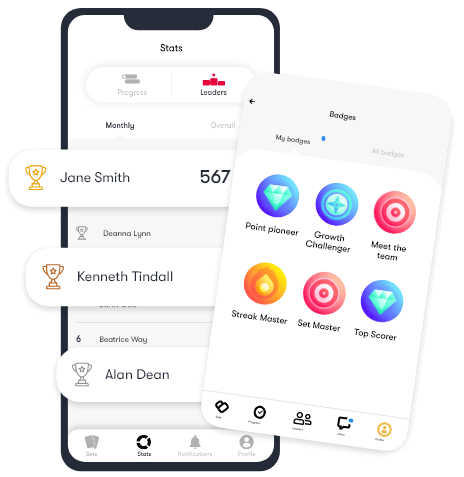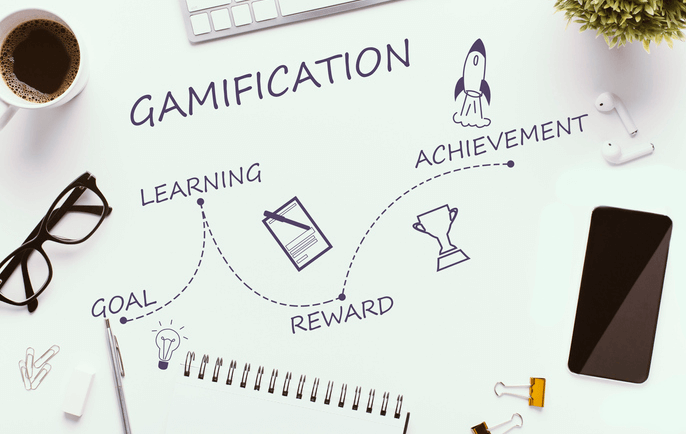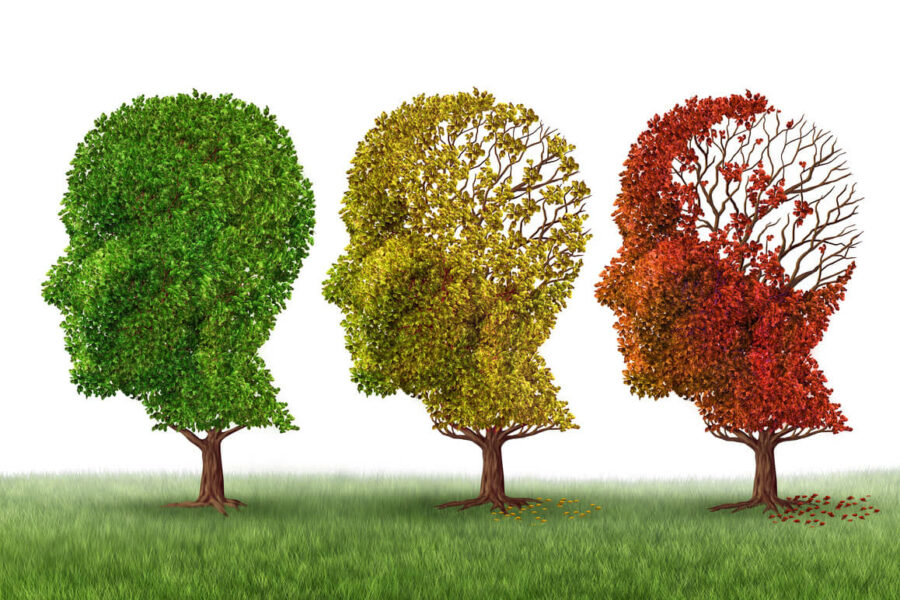If you look at your cell phone right now, you’ll likely find an app that uses gamification in business. Maybe you placed a mobile coffee order this morning to earn stars, or logged a workout to stay at the top of the leaderboard. Strong consumer engagement with smartphones is driving the growth of gamification in business. And that means now is the time to capitalize on incorporating it into your customer and employee experience.
Between 2022 and 2023, the global gamification market expanded from $14.87 billion to $18.63 billion, showing a growth rate of 25.3% annually. Predictions suggest that by 2027, this market will reach $46.44 billion, continuing at a similar annual growth rate of 25.6%.
With the largest gamification market in 2022 being North America, now is the time to capitalize on this growing trend.
- What is gamification?
- How is gamification used in business?
- Why gamification in business matters
- What is the value of gamification in the workplace?
- The top 7 reasons to use gamification strategies with employees
- The benefits of adding gamification to your business
- Gamification examples in business
- FAQs
- Key takeaways
What is gamification?
Gamification incorporates game-like features into non-game scenarios to motivate and engage users. It takes something already in existence and adds gaming features to increase participation.
Historically, gamification isn’t a novel idea. It has been used in some form for centuries to educate, entertain, and engage an audience.
What is gamification in business?
In business, this approach applies to customer engagement, employee productivity, education, and training. Elements like points, badges, and leaderboards boost user participation and guide behaviors.
How is gamification used in business?
Gamification in business isn’t just about playing games. It guides your user’s experience and gives you a unique insight into their behaviors.
Gamification in business normally takes on two forms: gamifying the customer’s experience, and/or gamifying the employee’s experience.
Engaging your users with game elements can include:
- Scoring points
- Leveling up
- Earning virtual currency
The goal is to effectively:
- Boost user engagement
- Drive conversions
- Improve operations
Common strategies for gamification in businesses include using virtual badges, interactive components, completion meters, and rewards for completing goals.
Why gamification in business matters
Figuring out the best ways to interact with your customers is an ongoing process. Gathering data for outcomes when using gamification has provided impressive stats. When done right, incorporating game elements can:
- Increase user engagement by up to 47%.
- Improve brand awareness by 15%.
- Increase brand loyalty by 22%.
But the benefits don’t stop there.
Gamification can help you learn more about your user’s behaviors. When they use game-like features, you get another view of what they like and where they spend their time. This information helps inform what their interests are.
Gaining this insight helps improve marketing plans, design user experience, and ultimately reach your business goals. Each interaction provides more guidance on what matters to your people.
What is the value of gamification in the workplace?
The benefits of gamification in business aren’t limited to the customer side. Incorporating gamification with your employees also holds value. It fundamentally boosts engagement, steering business outcomes. Employee interactions work in similar ways as with customers. You’re gaining insights into where they’re spending their time, and what activities hold their interest most.
Goal setting is one lever of gamification. Your staff will have clarity on what’s expected of them, while following the steps to get there. Between the start and finish lines, they’re able to see their progress, receive immediate feedback, and stay connected with co-workers.
The top 7 reasons to use gamification strategies with employees
- Enhances employee engagement, knowledge acquisition, and retention.
- Creates a level playing field for employees to showcase their value.
- Provides a fun and creative learning environment.
- Makes work processes enjoyable and rewarding.
- Facilitates effective training and skill development.
- Increases productivity, motivation, and employee advocacy.
- Improves the overall work environment and employee satisfaction.
Gamify employee training with a powerful microlearning app

The benefits of adding gamification to your business
1. Improve customer loyalty
- Retaining your current customers is a more cost-effective strategy than acquiring new ones.
- Devoted customers spend 3X the amount of the average customer.
- Customers who connect emotionally with your brand tend to hold greater lifetime value.
- Enhance customer experience
2. Enhance customer experience
- 86% of buyers will spend more for a great experience. And the pricier the item, the more willing they are to pay for that experience.
- Gamification can make the customer journey more enjoyable and rewarding. This helps improve how people feel about your brand and keeps customers returning.
- Businesses focusing on customer experience have witnessed an average profit growth of 80%.
3. Boost employee satisfaction
- A survey conducted by TalentLMS showed a drastic increase in productivity and happiness. Eighty-nine percent felt more productive, and 88% reported being happier at work.
- The same survey found that when comparing gamified to non-gamified training, 62% of employees feel motivated during their regular training, and this number increases to 83% with gamification.
- Boredom and unproductivity decrease from 31% to just 10%, highlighting a clear correlation between gamification and enhanced employee engagement.
Gamification examples in business
With business gamification gaining popularity, you’ve likely interacted with some of your favorite companies in this way. Here are a few that have incorporated gamification successfully.
Starbucks
Starbucks nailed it with its app and My Rewards program, making gamification a big part of its customer experience. Customers earn stars and rewards, boosting the Starbucks experience. Thanks to these fun gamification elements, Starbucks stays on top when it comes to keeping customers engaged and coming back for more coffee.
Domino’s
Domino’s has used gamification to boost customer loyalty and happiness by rolling out programs like the “Piece of the Pie Rewards.” This program lets customers earn points for their orders and then cash in those points for, you guessed it, pizza!
Samsung
Samsung has been a leader in using gamification in business. Their website’s “Samsung Nation” program turns interaction into a game. Members compete for rewards like badges and points, showing their dedication to using gamification to improve the customer journey.
Nike
Nike uses gamification in its Nike Run Club app to boost user engagement and motivation. By integrating rewards, badges, challenges, and leaderboards, the app encourages users to stay active and involved. An innovative gamification addition to the Nike experience is a sneaker try-on game in Chinese stores, showing their commitment to enhancing customer engagement and brand experience.
When adding gamification to your business, consider the following.
- Ensure alignment with organizational goals, focusing on behaviors that drive these objectives.
- Prioritize motivation and engagement, designing gamification to enhance enjoyment for your customers. If it’s not fun, they won’t interact.
- Plan for effective data collection and analysis to gain insights into customer behavior and preferences.
- Consider what incentives and rewards will encourage desired behaviors and boost engagement levels.
- Seamlessly integrate gamification into existing experiences to enhance instead of overhauling what’s already in place.
Remember, you want to enhance what is already in place and nurture your relationships.
FAQs
What is an example of gamification in business?
Nike’s Run Club App and Starbucks’ loyalty app for mobile users are two examples of gamification in business. The Nike Run Club app encourages users to maintain their fitness and engage with the app regularly by including rewards, badges, challenges, and leaderboards. Starbucks gives users stars as rewards to increase customer loyalty and boost engagement.
Gamification in business also works in the form of training. By gamifying employee training you’ll boost engagement and learning outcomes by helping teams learn and retain more information.
Why is gamification effective for business?
Gamification helps businesses improve operations and brand reputation, drives outcomes, and helps achieve goals. This happens by:
- Increasing user engagement and motivation
- Providing data for analysis
- Incentivizing desired behaviors
What are 5 gamification ideas?
Leveraging gamification to engage your customers can lead to positive business outcomes. Here are five ideas to get you started:
- Loyalty program
- Random rewards
- Interactive games
- Challenges and competitions
- Quizzes
Is gamification right for your industry?
If you’re aiming to bring customers back time and again, gamification is your ace in the hole. The strategy has proven to be a game-changer across industries. Whether you’re in the food and beverage, software and tech, or retail space, don’t overlook the power of gamification in business. This flexible tool easily fits into most industries. Customer experiences skyrocket and give you valuable insights into what your customer wants.
In this fast-paced world of business, gamification isn’t just a fad. It’s a way for businesses to level up and stand out in today’s competitive market.
Key takeaways
- Using gamification in business means spicing things up with game-like elements. This approach can be used both with your customer base, and your employee base.
- Gamification isn’t exclusive to certain industries; it’s a hit across the board— from food and beverage, software and tech, and retail.
- Remember, when integrating gamification, make sure it aligns with your company’s goals. Focus on nudging customers and employees toward actions that support these goals.
- Through gamification, you’ll unearth valuable insights into your customers and employees— their behaviors, preferences, and how they interact with your brand.


